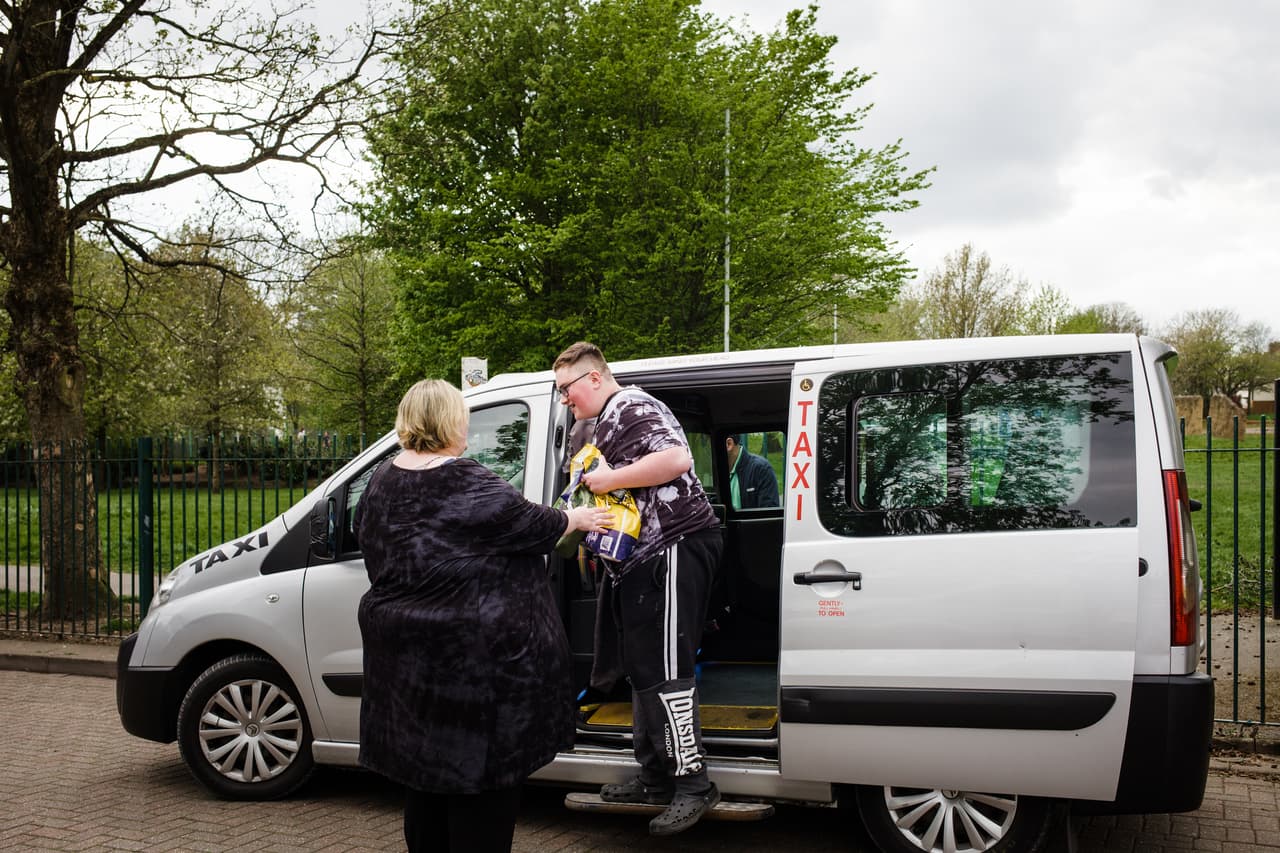
Cornwall to Newcastle: children with disabilities forced to travel hundreds of miles for school
Billion-pound deficit in Send system leaves families battling for precious few placements
Sam has always hated going to school. In fact, since he was two years old he has hated leaving the house at all. For years Julie Rae, his mother, had no idea why her son had to be dragged kicking and screaming to the front gate and then physically peeled away from her every day. At home, Sam’s violent meltdowns ended with him hurting either himself or his mother; it was clear he needed help. When he was seven he was diagnosed with autism.
By the start of Year 5, said Julie, Sam was shutting down in class. “He was unable to engage with anything,” she said. “He just shut down until he could explode and express the emotions that had built up. Nobody knew how to handle it. By October he was telling me he didn’t want to live.” Remembering it brings her to tears.
Sam needed more help than his school could provide. Yet the council – which initially argued Sam did not have learning difficulties at all – concluded in an assessment that his needs could be met by mainstream education.
It’s a pattern repeated up and down the country. Twenty-one councils already reject one in every three assessment requests. Some – including Julie’s local authority, East Sussex – turn down almost half. And the Bureau has found evidence that, under pressure from the government to bring spending down, even more councils are planning cost-cutting measures that threaten to prevent children from receiving support, or to reduce or remove the help they now receive.
Money – or the lack of it – influences every part of the system that supports children and young people with special educational needs and disabilities (Send). It determines what help children receive, which school they go to, and where.
The central problem is that funding has failed to keep pace with demand, creating a fast-growing financial black hole at the heart of the Send system. The Bureau can reveal that the deficit in England hit £1.3bn in March – an increase of more than £450m in the past year alone. Some local authorities saw their debt triple.
“I was told the decision for Sam’s future would not be [based] on what’s in his best interests – it would be in what’s the best value for money,” she said. “That killed me because what’s best value for money is not going to be what’s in his best interests … This is my child’s future, being decided on the bottom line.”
Broken system
As the government launches a major consultation about the future of Send provision, an investigation by the Bureau has uncovered the human consequences of a desperately underfunded system. With a huge deficit across local authorities in England continuing to grow, the result is an increasingly adversarial process in which parents, schools and local authorities are pitched against one another, with a child’s needs appearing secondary to financial costs.
 Sam is approaching a full academic year away from school
Alex Sturrock for TBIJ
Sam is approaching a full academic year away from school
Alex Sturrock for TBIJ
 East Sussex, where Sam lives, turns down almost half of all assessment requests
East Sussex, where Sam lives, turns down almost half of all assessment requests
Sam, now 12, no longer attends school. “He would stand there crying and screaming because he wanted to go to school [but] he has this internal conflict,” said Julie, who is trying her best to help him at home. “He knows he has to go to school but physically can’t make himself.”
In February, Julie appealed the result of the needs assessment. She now faces a wait of four to six months, by which point Sam will have missed an entire academic year. Her best hope is that she wins and he will return to education in September at an independent school for pupils with autism or dyslexia. She is, however, prepared for the worst.
The dual pressures of rising demand and increasing complexity of need have left councils without enough state-funded provision struggling to cope and hugely reliant on costly independent schools. It also means many children are sent to school in other local authorities, which in turn have to send local children elsewhere because those places have been taken.
Thousands of families have been forced to look far afield for suitable places – and children have to travel long distances to get there. More than 3,000 children are travelling further than 20 miles each way; one child who lives in Tameside has been placed in education 650 miles away in the Shetland Islands, with another from Cornwall at school 500 miles away in Fife. These are not isolated examples – the Bureau found more than 100 children placed more than 200 miles away from home.
Stephen Kingdom, of the Disabled Children's Partnership said: “This investigation has exposed worrying data about the distances disabled children are travelling just to go to school. Non-disabled children would never be expected to spend three hours on school transport every day. The longest journeys are often undertaken by children who need the most specialist provision.”
For many parents it has become a case of weighing up a place that meets their child’s needs against the stresses and strains of getting them there. Jayne Evans knows this balancing act well. Her son Dominic is unable to cope in mainstream education as a result of pathological demand avoidance (PDA), a profile on the autism spectrum.
 Dominic, who has autism, found primary school so distressing he would hide under his desk
Stéphanie Garstin for TBIJ
Dominic, who has autism, found primary school so distressing he would hide under his desk
Stéphanie Garstin for TBIJ
At primary school, Dominic refused to take part in lessons, hiding under his desk or in filing cabinets. So intense were his meltdowns that his school eventually reduced his attendance to just an hour a day, over lunchtime. At home he became so distressed that he began to hurt himself, and Jayne worried he might take his own life if he did not get help.
It took years before anyone would accept he needed support. Jayne was told Dominic was not autistic and did not have ADHD; that she was an “overbearing” mum who wanted something to be wrong with her son. Eventually he was transferred to a pupil referral unit, an alternative to school for children who struggle in mainstream education. When that placement collapsed, Dominic’s school finally decided he needed an education, health and care (EHC) plan, a document that sets out the additional learning support a child is legally entitled to and where they should receive it.
Jayne looked for a school in Wolverhampton, their local area, that could meet her son’s complex needs, but the nearest one she found was in Worcestershire, 20 miles away. Dominic now makes a three-hour round trip there and back every day. To make matters more complicated, he does so in a taxi with another child who also has complex needs.
The Bureau found that, due to lack of transport provision, more than 13,000 special needs and disabled children in England travel to and from school in private taxis as the sole child in the car. Not only do these journeys generate a huge expense for the councils in question but, for a child with ADHD or autism, they can be enormously stressful.
“We’ve had a lot of problems,” said Jayne, who would have to give up work in order to drive Dominic to school herself. “It’s two very complex children who set each other off. The driver doesn’t understand Send. If one of them gets upset or goes into crisis, he starts shouting.” More than once Dominic has fled the vehicle and run away along a busy road. Even on less dramatic days, the children are often late. It affects their education.
But Jayne believes the challenges are worth enduring. “It’s a trade-off, we knew it from the minute we looked at it,” she said. “We made the right choice. I’d still make the same choice.” Since starting his new school, Dominic has “come on leaps and bounds from the child we thought wasn’t really going to achieve much,” she said. “We thought, ‘As long as we can get him happy, that’s an achievement.’ That was all we were hoping for. But he’s actually sitting GCSEs this year. He’s thriving, he’s doing really well.”
A domino effect
Dominic’s story will be familiar to many. Freedom of information requests submitted by the Bureau to councils in England show that at least 43,000 children with EHC plans are in schools or other education establishments outside their home council area. Of those, more than 3,300 have to travel an estimated 20 miles or more away – the maximum distance MPs on the education select committee suggested that children in the care system, a similarly vulnerable group, be moved away from where they live.
Some of the distances are much higher. Seven children from North Tyneside are placed in Harrow, north London, around 270 miles away. Two young people from Islington are being educated in Cumbria: 280 miles in the opposite direction. Cornwall is one of 12 councils in England with Send children attending provision in Scotland, and has also sent children to Stockton-on-Tees in the north-east and Denbighshire in Wales.
Merton has the highest proportion in London of children educated out of borough. More than 1,000 children are spread across almost 40 other local authorities, including in Derby, Dorset and Norfolk.
At times the situation appears self-defeating. Windsor and Maidenhead places a fifth of all its EHC plan pupils in more costly independent or non-maintained schools, because its own state capacity is used up by other local authorities. In Rutland, in the east Midlands, 38% of children with an EHC plan have been placed there by other local authorities – the highest proportion in England. In turn, Rutland has the highest proportion of children educated outside its borders. The council said it was aware of both issues and had published an inclusion strategy that will address “the need for Rutland children to remain in local provision”.
Christine McInnes, director for education at Kent county council, told the Bureau: “There are children spending two hours being transported to a special school. To what benefit? I’m not saying that should never happen, but it should only happen in extreme cases because actually you’re taking 10 hours a week out of that child’s life when they should be doing after school activities, meeting with friends, and having a life. Instead, they’re spending it being transported around.”
Katie Ghose, chief executive of the disabilities charity Kids, said an out-of-borough placement “can cut [a child] off from the same opportunities to live, learn and thrive at home and in their local community as enjoyed by their non-disabled peers. Yet with early intervention and the right support, many children and young people could be educated in their local school.”

‘The only route the council will be able to take’
As more children are placed further away or in independent schools, the cost to councils of providing specialist education rises. Bournemouth, Christchurch and Poole council’s deficit more than doubled to £18.6m in 2021-22. Independent school placements are the most significant pressure on its budget. The council had hoped to reduce them but admitted “there is no indication yet this can be achieved” in a report published in December.
Hillingdon council in London recently required emergency government intervention to reduce its £34m special needs debt. A council report said a “continuing lack of capacity in-borough and across other local authority provision” forced the council to turn to independent schools. “There is an expectation that this will become the only route the council will be able to take until more provision is created locally,” it added.
A child’s EHC plan is paid for through the dedicated schools grant, the main pot of money allocated by the Department for Education to local authorities and then distributed to schools. But with councils legally obliged to organise and fund the EHC arrangements, three in every four have amassed deficits. Kent, Surrey, Devon, Hampshire and Norfolk are particularly badly affected – deficits across these five councils were together expected to grow by almost £190m in the past 12 months.
Kent’s deficit has reached £103m – in cash terms, the largest in the country. In a candid interview the council’s special educational needs and disabilities director, Mark Walker, said parents had lost faith in the ability of Kent’s mainstream schools to meet their children’s needs. As a result, he explained, the council receives a higher proportion of EHC plan applications from parents than schools. What parents want, Walker said, is places at expensive independent schools and he blames the Send Tribunal, which hears appeals against local authority decisions, for helping them get their way. In 2020-21, this national independent tribunal ruled in favour of parents in 96% of cases.
He gave dyslexia as an example, explaining that the council has a well-qualified speech and language service and an educational psychology department specialising in the condition. “Why then are we losing a tribunal for parents that want to go to Frewen College, which is an independent college in East Sussex?” Frewen is one of a small number of dyslexia schools in the UK. Its fees start at £6,500 a term.
He added: “It’s a beautiful building, fantastic facilities – they’ve got a swimming pool there and everything. As a parent, if I see that, I want that sort of education for my child. I know why people go for it. But that’s different from, I think, what was expected within the [Send] Code of Practice.”
Frewen’s principal, Nick Goodman, said these notions of luxury were misguided. “It is indeed in a lovely setting,” he said. “It is a not-for-profit charitable trust. It does indeed have a swimming pool – outdoor, unheated – and many of our classes are taught in temporary classrooms dating back to the 1980s. A look at our accounts will confirm that margins are tight. It is not the buildings or the swimming pool that make Frewen College attractive to the parents of students with specific learning difficulties. It is the provision and outcomes.”
Walker believes the answer to reducing the deficit is to increase inclusion at mainstream schools. “We need to make sure parents in Kent don’t think they have to get an EHC plan in order to get the type of support their son or daughter needs,” he said. The deficit, he said, would take years to reverse.
Councils with deficits have to submit plans to the Department for Education on how they intend to balance their books. Some include proposals to amend thresholds for which children are eligible for the education, health and care needs assessment that marks the first step towards securing an EHC plan – thresholds that have no legal standing.
Bury and Derby councils both included language about clarifying or reviewing assessments in their plans as part of their cost-cutting measures. Bury told the Bureau that while it was not looking to raise thresholds “across the board”, some schools in the area had incorrectly put children forward for assessment and that for these schools, the thresholds needed to be “clarified”. Derby council said it was “working with all partners … to make Derby a more inclusive city, to find ways of strengthening the system and balancing the budget”.
Get involved
Want to investigate this story in your area? Use our reporting recipe to dig into the local data
Find out moreSome councils already turn down a high proportion of assessment requests. In 2020, nine local authorities (Warwickshire, Liverpool, Medway, West Sussex, East Sussex, Southend-on-Sea, Staffordshire, Southwark and Peterborough) turned down 40% or more, about twice the national average. In 2020, Peterborough council turned down half of all the assessment requests it received – the highest rejection rate in the country.
A spokesperson for the Local Government Association said: “Meeting the year-on-year increase in demand for Send support is one of the biggest challenges that councils are dealing with. Councils lack the levers to bring this spending under control and this is a key issue that needs to be addressed.”
Years from reform
In March, the government published its much-anticipated green paper outlining proposals for the future of Send provision in England. Proposed changes include digitising EHC plans to make the process more straightforward, new banding and tariffs around high needs to “put the system on a financially sustainable footing”, and a drive to promote inclusivity in mainstream schools. There will also be £2.6bn to create new special school places over the next three years.
These reforms could take years to introduce. Meanwhile, thousands of special needs and disabled children will continue to struggle to access a suitable education.
Rachel Ryan is another parent who has faced a tough search for the right school. She told the Bureau that due to a lack of suitable provision in Liverpool, where they live, the only option for her 10-year-old son Charlie, who is autistic and dyspraxic, is an independent school outside the city.
Charlie’s EHC plan application contained detailed professional advice in support of his case, but the council named a different school – a decision Rachel is now appealing.
“Local authorities don’t want these children in independent schools because they’re costing too much money,” she said. “Instead they put them somewhere that’s going to be cheaper, and that’s taking precedence over their well-documented needs.”
Header image: Sam at home. He no longer attends school. Credit: Alex Sturrock
Reporter: Gareth Davies
Additional reporting: Ioana Cerasella Chis
Data analysis: Charles Boutaud
Community organiser: Ioana Cerasella Chis
Bureau Local editor: Emily Wilson
Editor: Meirion Jones
Production editors: Alex Hess and Emily Goddard
Fact checker: Alice Milliken
Our reporting on local power is part of our Bureau Local project, which has many funders. None of our funders have any influence over our editorial decisions or output.
-
Area:
-
Subject:






